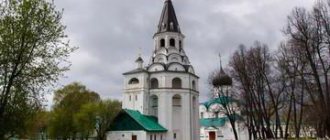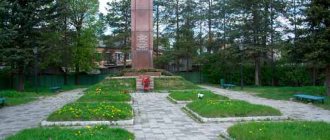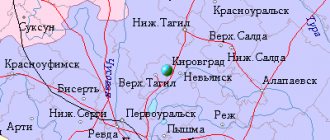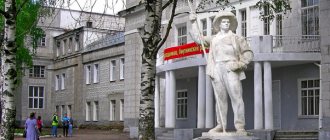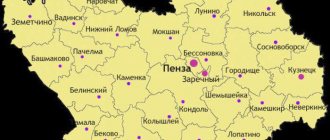History of the city of Kamenka, Penza region
District center. 75 km west of the city of Penza, Belinskaya railway station on the Penza-Moscow line, Penza-Tambov highway. Located on both banks of the Atmis (the left tributary of the Moksha). As of January 1, 2006, the area is 2395 hectares, 39917 inhabitants.
The main industries are agricultural engineering, the food industry, and the building materials industry. As of January 1, 1995, the largest enterprises were: Belinskselmash JSC (over 3 thousand employees) - seeders, cultivators, potato planters, harrows, etc.; meat processing plant (773 people); sugar (779 people); brick factory (125 people); elevator (282 people); (395 people) – reinforced concrete and carpentry products. Creamery, bakery (confectionery, canned vegetables), brewery, cereal factory, etc. Railway station, bus station, passenger vehicle enterprise (25 buses, 7 city routes). – repair of cars of all brands; JSC Kamagroservice – maintenance of agricultural machinery and livestock farms. 3 mobile mechanical columns “Agropromspetsstroy”, 2 – “Penzvodmelioration”. Branch of the commercial bank "Tarkhany". On the balance sheet of the city's housing and communal services are 80,977 sq. m of housing, including 72,823 sq. m with all amenities (1989).
As of January 1, 1995, there were city (260 beds) and district (310 beds) hospitals, 2 health centers, 3 pharmacies. 9 secondary schools, incl. 8 secondary (6272 students); mechanical engineering college (286 students), vocational school No. 13 (trains specialists in mass professions for the village). 3 houses of culture, 6 libraries, music and art schools, a park of culture and recreation, a cinema, 2 stadiums, 2 children's and youth sports schools. 2 churches (Dmitrievskaya and Sergievskaya). Intracity television has been operating since January 1993. 4 monuments to soldiers who died during the Great Patriotic War - fellow countrymen and those who died in the local evacuation hospital. 11.5 thousand pensioners.
The historical center of the city is located on the right bank of the Atmis. The planning structure of the right bank part is curvilinear, oriented towards the shore line, the transverse streets stretch towards the river. In the second half of the 19th century, administrative buildings were built in the central part, which, together with shops and Voeikov’s estate, formed a well-defined trading area. The bridgehead square appeared thanks to the development of the right bank. Large construction began in connection with the evacuation to Kamenka and receiving the status of a workers' settlement on June 15, 1944, and the status of a city on April 18, 1951. The left bank part developed at a high rate, where the main housing construction was located in connection with the deployment on the left bank, where 2 thousand people worked at the end of the war. Its layout is distinguished by a rectilinear grid of streets with multi-apartment sectional buildings.
The administrative center remains in the old part of the city, here on the bridge square there is a memorial to fallen soldiers, and on Sovetskaya Street there is a system of public gardens, administrative buildings, a number of architectural monuments: the former Land Peasant Bank (1913), post office (1913), estate complex, with a palace , owner of local lands Voeikov (1914), on Pervomaiskaya Street - a hotel of the second half of the 19th century. In the 1990s, in the area of the railway station, a residential microdistrict was built with German funds for military personnel withdrawn from this country.
Kamenka was founded at the beginning of the 18th century in the area of an ancient stone ford across the Atmis River on the way from Penza to Nizhny Lomov and Tambov, and even earlier, apparently, from the Golden Horde city of Ukek (Uvek in Saratov) to the city of Mokhshi (Narovchat). The settlement was named after this ford. In 1710 - a village with 8 courtyards of Major General Ivan Mikhailovich Golovin. In 1717, the village of Dmitrievskoye (after the church in the name of St. Dmitry Selunsky), Kamenka, too, was devastated by the Kuban. At the end of the 18th century, it was an agricultural village with small oil mills based on hemp cultivation and potash factories; there were 4 water mills on Atmis. Thanks to the Penza-Tambov highway, peasants earned extra money by transporting merchant goods, engaged in small trade and providing services to travelers. Local residents participated in the Peasant War on the side of E.I. Pugachev (1774), and the peasant Ivan Ivanov gathered a small detachment here with which he tried to capture Penza. In 1795, all 165 peasant households in the village of Dmitrievskoye and Kamenka were on quitrent and paid 3 rubles per revision person per year. In the middle of the 19th century, on Frolov’s estate, Angora rabbits were bred here to obtain wool from them; A.P.’s distillery operated nearby. Bystrovoy. At the end of the 19th century, there were 503 Baptists and Old Believers of the Beglopopovian persuasion in the village. In 1918, a second-level school opened. From the time of its foundation until 1928, the settlement was part of the Nizhnelomovsky district, and since the 1860s it has been a volost center. In the 1870s, thanks to the efforts of the local landowner General Voeikov, the railway from Moscow to Penza passed through Kamenka, and the station was named Voeikovskaya. In 1878, a zemstvo school opened in the village. In the 1900s, while commandant of the Winter Palace in St. Petersburg, he announced his intention to build a resort in Kamenka and cure Tsarevich Alexei of hemophilia. It was for the prince that Voeikov's palace in this village was intended. At the same time, the owner of the palace did a lot to promote the healing properties of local water from springs in the Kuvaka ravine, launching a carbon dioxide production plant for this purpose. In 1913, there were about 30 small enterprises: steam mills, cereal mills, hemp milling, carbon dioxide, brick, etc. During the Russian Revolution of 1905–1907, it was one of the major centers of the agrarian movement in Nizhnelomovsky district. In October 1913, a monument to the “Tsar-Liberator” Alexander II was unveiled in the center of the village; the ceremony was attended by the commandant of the Winter Palace V.N. Voeikov and the Penza governor Lilienfel-Toal. During the First World War, Voeikov opened an infirmary for the wounded in the village, on the basis of which a hospital was opened in 1918, one of the best in the province. In the summer of 1918, an anti-Bolshevik rebellion occurred in the village, suppressed by the Penza Red Guards. In 1920, on the basis of capacities taken from private owners, an industrial plant, food industry enterprises, and one of the first agricultural artels in the province, “Mayak” (1918), operated. Since 1928 it has been the regional center of the Middle Volga (Kuibyshev) region, since 1937 - the Tambov region, and since 1939 - the Penza region. In 1938, there were 430 workers at the brick, cereal, butter and cheese factories, elevators, etc., the length of the streets was 15 km, of which 7 km were paved; there were 5 schools, a hospital with 70 beds, a cultural center, 3 clubs, 3 libraries, and a recreation center with 250 beds. The process of transformation from a village to a city was accelerated by the Great Patriotic War, since a factory for the production of agricultural machinery evacuated from Kirovograd (Ukraine) was located in Kamenka, which began to produce weapons, as well as mines and shells here. An evacuation hospital was set up in Voeikov’s former estate. Since 1943, the plant also began to produce horse-drawn seeders, since 1946 - tractor seeders, and since 1950, potato planters. Since the mid-1950s, the company's products began to enter the world market.
*On November 6, 1957, in Kamenka, for the first time in the USSR, in a regional center, a television center was founded. The television center was the first in the Penza region. The equipment with which it was possible to receive a television signal and rebroadcast it on the air was made by local enthusiasts, including Boris Shumov. Together with his friends, he brought discarded parts from a television manufacturing plant in the city of Voronezh. The television transmission center in Penza began work two years later.*
In December 1975, in connection with the expansion of sugar beet crops in the Penza region, a sugar factory (one of the largest in the USSR) was built, and a cattle feeding station was established within it.
The largest enterprise - - was transformed into a joint stock company (as of January 1, 1995 - 3025 employees). Meat processing plant – JSC “Kamenka-myaso” (773 employees), sugar plant (779 employees); brick factory (125 employees); elevator (282 employees); No. 5 (395 employees), LLP "Pishchevik" - production of confectionery products and canned vegetables (100 employees), etc. 30 stores. 2 churches – Dmitrievskaya and St. Sergius. Since 1993 - intracity television. 4 monuments to defenders of the Fatherland. Homeland of academician of medicine N.N. Burdenko (1876–1946), Minister of the USSR, deputy of the Supreme Soviet of the USSR, laureate of the State Prize of the USSR P.I. Parshin (1899–1970), Hero of the Soviet Union V.S. Parshin (1921–1943), poet M.I. Kirillova (born in 1949). Place of residence of Heroes of the Soviet Union V.S. Dyatlova (born in 1910), M.N. Khukhlova (born in 1921), full holders of the Order of Glory G.Ya. Laukhin (b. 1911), Hero of Socialist Labor E.V. Krezova (born in 1935). Hero of Socialist Labor, deputy of the Supreme Council of the RSFSR V.L. lived and worked in the city. Belyakova (1925–1973).
Population: in 1717 – 52, 1795 – 1197, 1864 – 1695, 1897 – 3409, 1926 – 5229, 1939 – 8265, December 1943 – 13026, 1.1.1946 – 9342, 1959 – 27101, 197 0 – 29421, 1979 – 35425 , 1989 – 39621, 1995 – 45900 inhabitants.
Homeland of the academician of medicine Burdenko Nikolai Nilovich (1876–1946), Minister of the USSR, deputy of the Supreme Soviet of the USSR, laureate of the USSR State Prize Parshin Pyotr Ivanovich (1899–1970), Hero of the Soviet Union Parshin Viktor Stepanovich (1921 - 11/14/1943), poet Mikhail Kirillov Ivanovich (born January 14, 1949). Place of residence of the Heroes of the Soviet Union Vasily Semenovich Dyatlov (08/15/1910 - 07/21/1988), Mikhail Nikolaevich Khukhlov (11/27/1921 - 11/05/2004), full holders of the Order of Glory Gavrila Yakovlevich Laukhin (06/13/1911 - 06/14/2004). 1997) and Yanaeva Khamzi Ismailovich (06/02/1924 - 11/04/1997), Hero of Socialist Labor Evgeniy Vladimirovich Krezov (b. 06/13/1935). Hero of Socialist Labor, deputy of the Supreme Council of the RSFSR Valentina Leonidovna BELYAKOVA (02/08/1925–01/20/1973) lived and worked in the city.
Literature: 1. Krylov G.I. Kamenka. Saratov, 1980. 2. Feldman P.A. Kamenka and Kamensky district. 3. Poluboyarov M.S. Kamenka / Penza Encyclopedia. M.: Scientific publishing house "Big Russian Encyclopedia", 2001, p. 226-227. 4. Poluboyarov M.S. — https://suslony.ru, 2007. 5. *22 TV channel, Penza.
The military airfield in Kamenka was destroyed
In the city of Kamenka, Penza region, the dismantling (destruction) of a military airfield is now in full swing. This is evidenced by the document that Yuri Vladimirovich Voblikov introduced us to. The document is a letter from the Administration of the city of Kamenka addressed to human rights activist Yu.V. Voblikov in response to his request regarding the dismantling of a number of objects in the city of Kamenka.
Here are the words from the passage that talks about the dismantling of airfield slabs:
“Artificial runway, grass area [as in the text, obviously, instead of “gas area” - ed.] , central vehicle refueling and parking area, connecting track - 1, connecting track - 2, connecting track - 3, connecting taxiway track – 4, connecting taxiway – 3, connecting taxiway – 2, connecting taxiway – 1, main taxiway, canteen, barracks, hereinafter referred to as the airfield, are assigned under the right of operational control to military unit No. 09436, i.e. is owned by the Ministry of Defense of the Russian Federation." “According to the letter of the General Staff of the Armed Forces of the Russian Federation dated August 24, 2013 No. 312/4/7709, sent to the Government of the Penza Region, it follows that the airfield in Kamenka is not used in the interests of the Ministry of Defense of the Russian Federation and in accordance with the promising system of basing the Russian Armed Forces to There are no plans for further use for its intended purpose.” “...The dismantling of the slabs was carried out by representatives of the Ministry of Defense of the Russian Federation in accordance with the work orders issued by the engineering and airfield service of military unit No. 94198-K. “Based on the above, the administration has no legal grounds for the use and disposal of these objects.”
We ask readers to forgive us for the long quote, but this excerpt perfectly reflects the whole situation. It would seem that everything is correct and logical: the Kamensky airfield is the property of the Ministry of Defense, and it, as the owner, can do whatever it wants with it. If he wants, he can even grind all the concrete slabs into powder and scatter them to the wind, and the Kamensk administration will not be able to present any justified claims to him.
In a good way, in order to avoid dismantling, it was necessary to contact the security forces, and not the district administration, but the train has already left, and nothing can be corrected. Soon, only horns and legs will remain on the site of the Kamensky airfield. And all this will be done legally.
But besides the law, there is also common sense. And he says this: there is now only one airfield left in the region. It is located in Penza. Airplanes take off and land on it. If any accident, natural disaster or, God forbid, a terrorist attack suddenly occurs, as a result of which the Penza airport is out of order, then the planes constantly circling in the air will have nowhere to land.
During the Soviet years, every region had a reserve airfield, or even more than one.
In the Penza region, this was the Kamensky military airfield . Now he is gone, and, in case of any opportunity, the pilots will have to land the car at the devil's horns.
But landing a large passenger airliner is not an easy thing. Not long ago, the media wrote about the high state awards received by two Moscow pilots who managed to land an emergency plane in a corn field near Zhukovsky on August 15, 2021. For this, both pilots were awarded the star of the Hero of Russia. But the landing was not a soft one. Many passengers were injured.
This well-known example illustrates well how difficult it is to land an airplane. And this task becomes tens of times more difficult if there is no solid concrete strip under the wheels of the chassis at that moment.
The question is, couldn’t the district and regional administrations have come up with such a simple idea? Why didn't they do everything possible to prevent the airport from being dismantled?
Why didn’t the regional leadership contact the Ministry of Defense, the General Staff, and finally the Supreme Commander-in-Chief? Just don't say that nothing could have been done.
Why do they endanger people's lives with such frivolity?


